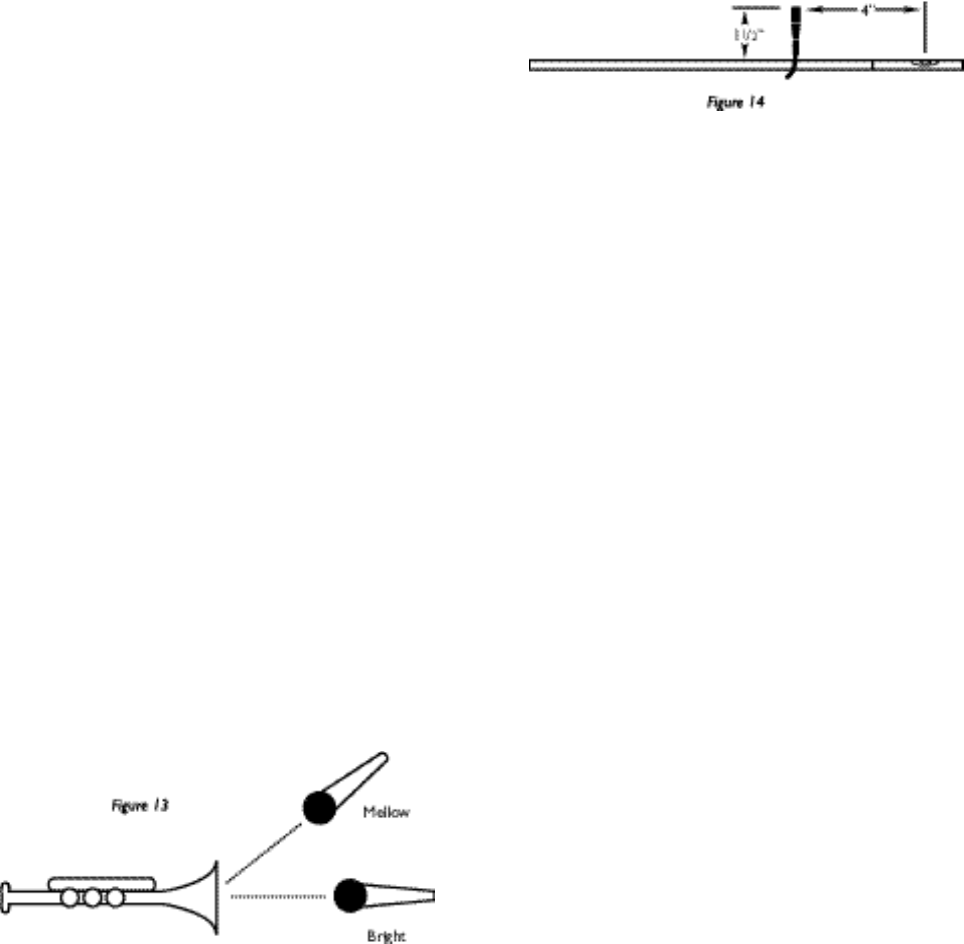
• For maximum isolation and gain-before-feedback,
use a GLM-100 close to the drum head a few inches
in from the rim.
• Place a CM-700 12 inches from the drum head for
recording, closer for sound reinforcement.
Violin
Recording:
• Place a CM-700 or CM-150 1 to 2 feet away over the
top.
• Attach a GLM-UM Universal Mount to the tailpiece
and place a GLM-100 over an f-hole. Experiment
with miking distance to get a good compromise
between tone quality and isolation.
Reinforcement:
• For more gain-before-feedback, put the GLM inside
the violin through the f-hole or clip it to the bridge.
Mandolin, Bouzouki, or Dobra
Recording/Reinforcement:
• Place a CM-700 12 inches away for recording, closer
for sound reinforcement.
• Mount a GLM-100 on the sound board near
an f-hole.
Acoustic Bass
Recording/Reinforcement:
• For a natural sound, place a GLM-100 or CM-700
on a boom a few inches out front, above the bridge.
• Tape a GLM-100 cable to the bridge.
• For a full, deep tone, tape a GLM-100 near an f-hole.
• For isolation, place a CM-200A near the f-hole and
roll off excess bass.
Brass
Recording/Reinforcement:
• Place a CM-700 or CM-200A a few feet out front.
Mic on-axis to the bell for a bright, edgy tone; mic
off-axis to the bell for a mellower tone (Figure 13).
• Attach a GLM-UM Universal Mount to the bell, and
position a GLM-100 about 4” from the bell, off-
center.
Woodwinds
Recording/Reinforcement:
• Attach a GLM-UM Universal Mount to the bell, and
position a GLM-100 or GLM-200 to pick up both
the bell and the tone holes.
• Place a CM-700 about 12 inches from the tone holes.
Flute
Recording/Reinforcement:
• Place a CM-700 halfway between the mouthpiece
and the tone holes about 6 inches away.
• For recording or low-level sound reinforcement, use
tape, a rubber band, or a padded broom holder to
mount a GLM-100 on the flute. Attach the GLM
cable 4 inches to the left of the lip plate (looking at
the player), with the mic capsule 1
1
⁄
2
inches above
the flute (see figure 14).
• For extra gain-before-feedback, tape the cable to the
end of the flute nearest the lip plate, so that the mic
can “see” the lips. Roll off the excess highs on your
mixer.
Dulcimer
Recording/Reinforcement:
• Tape a GLM-100 on the center of the top edge,
1
⁄
2
-
inch above it.
• Place a CM-700 about 8 inches above and in front of
the center of the top edge.
Harmonica
Recording/Reinforcement:
• Place a CM-200A a few inches to 1 foot away. Hand
hold the mic for sound reinforcement. For a bluesy,
dirty sound, pick up the harmonica with a mic
plugged into a guitar amp, and mike the amp.
Harp
Recording:
• Aim a CM-700, CM-150, or GLM at the sound board
about 18 inches away.
• Tape a GLM-100 to the sound board.
11
How to achieve a natural
tone quality
• Use a microphone with a flat frequency response,
such as: CM-700, CM-150, GLM-100, PCC-170,
PCC-130, any LM mic, or a PZM-30D or PZM-6D
set to “flat” response.
• Place the microphones as far from the sound source
as the source is big. For example, the sound board of
a guitar is about 18 inches long. Place the mic at least
18 inches away to pick up all the parts of the guitar
about equally.
• If you must mike close to reduce feedback or leak-
age, use your mixer’s EQ to restore a natural tonal
balance.
How to achieve a bright
tone quality
A “bright” sound is crisp, clear, trebly, and articulate.
To achieve a bright sound, use a microphone with a
rising high-frequency response, such as a Crown
GLM-200 or a PZM-30D / PZM-6D set to “rising”
response.
How to achieve a good balance
A good balance is a good loudness relationship
among instruments and voice in a mix. When the
balance is good, no instrument is too loud or too soft.
To achieve a good balance when recording a large
ensemble with one or two microphones:
• Move instruments that are too quiet closer to the
mics, and vice versa.
• Place the mic(s) far enough away so that you don’t
over emphasize the instruments in the center of
the ensemble.
• If you’re using two mics to record stereo, increase the
microphone angling or spacing. If you hear a hole in
the middle when using widely spaced mics, add a
third mic in the center, panned to the center.
• If a soloist is performing in front of an orchestra,
raise or lower the mic stand to vary the balance
between the soloist and the orchestra.
NOTES ON CROWN
MICROPHONE MODELS
CM-200A
The CM-200A is a handheld condenser microphone
with a smooth, articulate sound quality. It will not
overload no matter how loudly you scream into it.
Because of its cardioid pickup pattern the CM-200A
rejects sounds approaching the rear of the micro-
phone, so aim the rear of the mic at your floor moni-
tor speakers. Use the foam pop filter to reduce breath
pops.
CM-310A
The CM-310A is a handheld cardioid microphone
that is noise-cancelling or differential. “Differential”
means it cancels sound at a distance, and “cardioid”
means it cancels sound from the rear. Because of these
abilities, the CM-310A permits extremely high gain-
before-feedback and isolation. To keep from cancel-
ling your voice, you must use the microphone with
lips touching the grille. Sing directly into the front of
the microphone, not the side, or else your voice may
get cancelled and sound thin.
CM-311A
The CM-311A is a headworn cardioid microphone
that is noise-cancelling or differential. The mic’s
capsule is directly in front of your lips. Like the
CM-310A, the CM-311A has outstanding gain-
before-feedback and isolation. Lightweight and
comfortable, it adjusts to fit any head. The CM-311A
comes with an Adapta-Pak belt pack that works with a
9V battery or phantom power. Model CM-311AE is
the headworn mic alone, meant for connecting to a
wireless mic transmitter of your choice.
CM-312A
The CM-312A is a headworn hypercardioid mic that
is meant for less critical situations than the CM-311A.
The mic capsule in the CM-312A is at the side of the
mouth, and is very small and light. Model CM-312AE
is the headworn mic alone, meant for connecting to a
9V-powered wireless mic transmitter of your choice.
CM-30/CM-31
The CM-30 is a miniature supercardioid condenser
mic designed for overhead miking, such as over a
choir. It is slightly bigger than the GLM microphones
described below, but has lower noise. The CM-30
power module mounts in an electrical box in the
ceiling; the CM-31 power module is a cylinder with
an XLR-type connector. Both mics come in black or
white. CM-30L and CM-31L have 60’ cables.
CM-700
The CM-700 is a superb, cardioid condenser mic
for pro or semipro recording and high-quality sound
reinforcement. Rugged enough for the road, the
CM-700 works equally well for popular music (multi-
miking) or classical music (stereo and spot-miking).
It’s also a good choice for miking a lectern on a boom
stand.
6
















